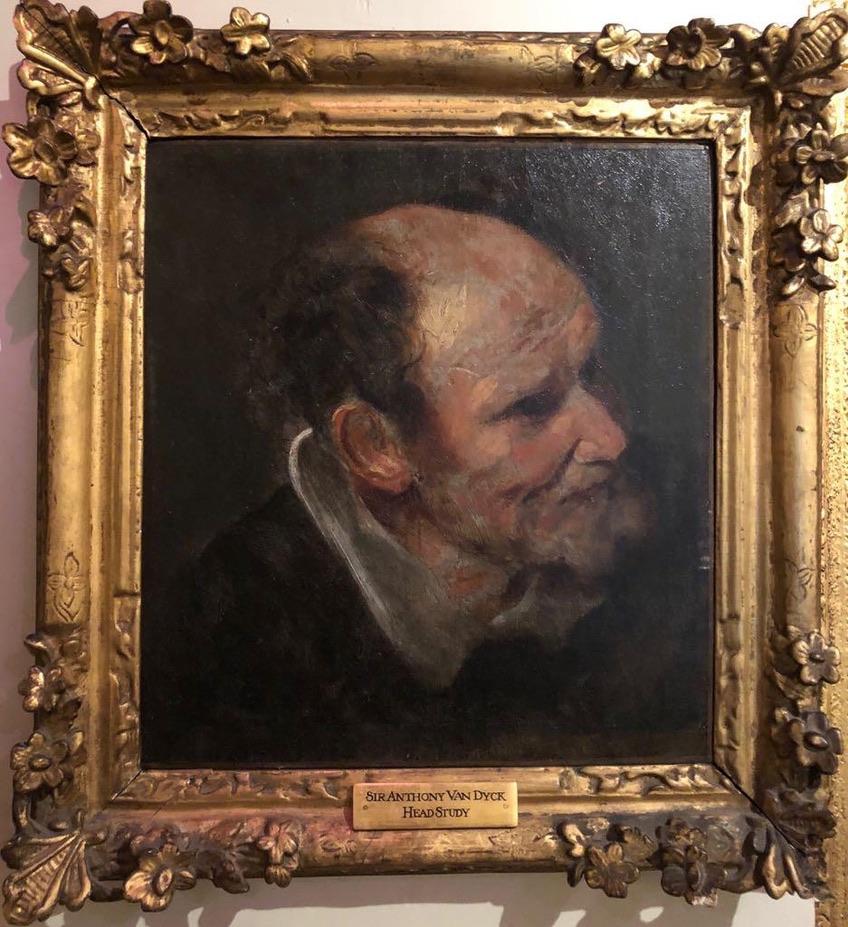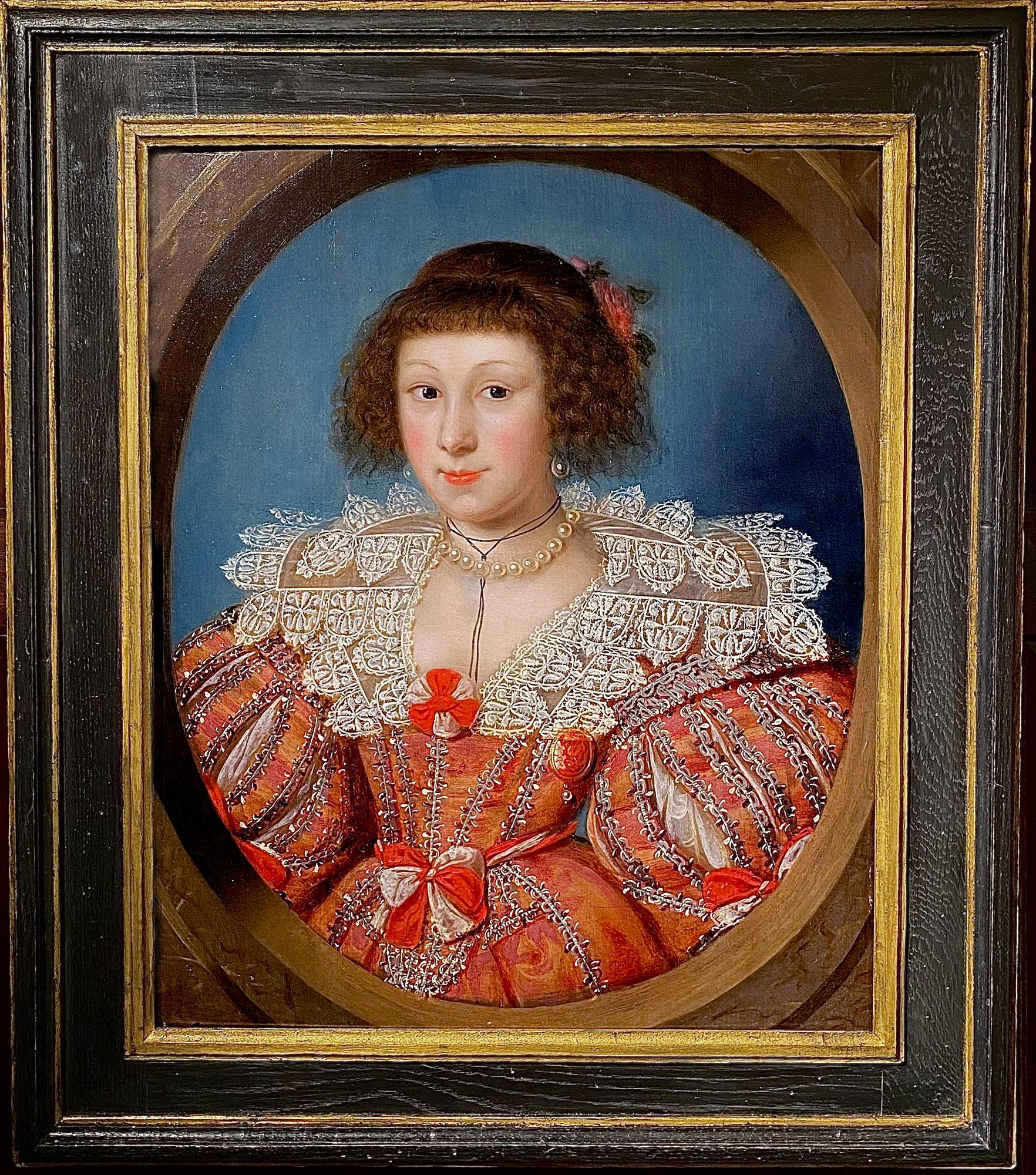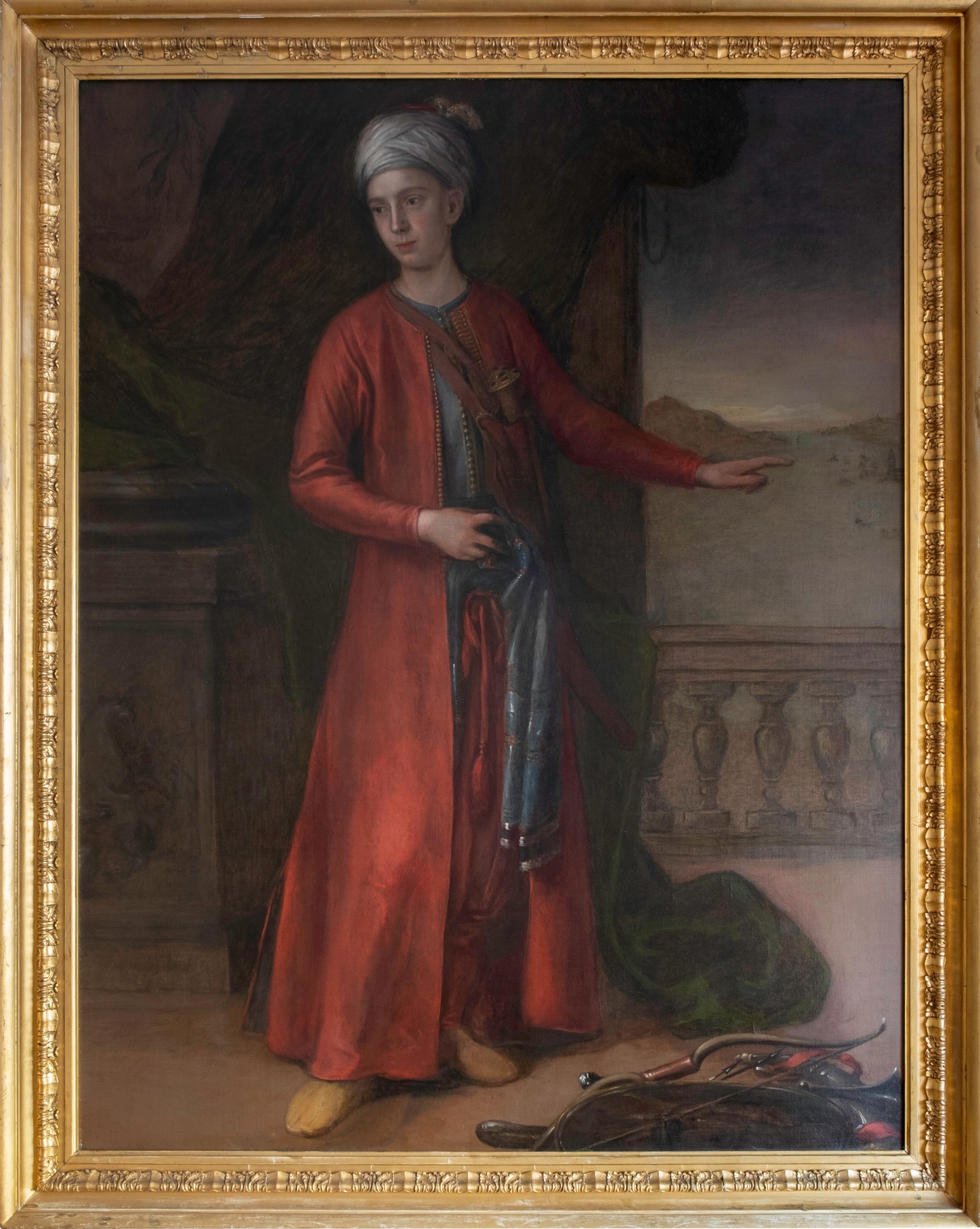Items Similar to Mary Beale (circle) Portrait Painting of Sir John Pettus
Want more images or videos?
Request additional images or videos from the seller
1 of 9
Mary Beale (circle) Portrait Painting of Sir John Pettus17th century
17th century
About the Item
A very fine oil on canvas of Sir John Pettus ,circle of Mary Beale 17th century
Wearing a red cloak and a black tunic with white collar. His coat of arms to the right.
Housed in a gilt frame, the size overall being 85 x 74 cm whilst the painting is 76 x 63.5cm
In overall excellent condition.
There is a wealth of history about the sitter online , below is a brief resume
John Pettus
Sir John Pettus (1613–1690) was an English royalist, politician and natural philosopher. Pettus was an expert on metallurgy and became a deputy governor of the royal mines in England and Wales under Charles I and II. He is known for the first English translation of the work of the German metallurgist Lazarus Ercker.
Pettus’s grandfather was a wealthy Norwich merchant ,he purchased the manor of Rackheath in 1590 and represented the city in 1601 and 1604-10. Although a younger son, Pettus inherited the manors of Chediston and Wenhaston, He married well; but even before the Civil War most of his estate was mortgaged, and his wife’s expectations were never realized, owing to her father’s misfortunes as leader of the City Royalists. Pettus became a servant to Charles I, and took part in the farcical royalist attempt on Lowestoft in March 1643, but was exchanged after nearly a year in prison. It is unlikely that he resumed command of his regiment, such as it was, since he ‘continued inoffensive till the taking of Bristol’ by the New Model Army in September 1645. Presumably it was this episode that entitled Pettus many years later to describe himself as having served under Prince Rupert
Mary Beale
Mary Beale was an English portrait painter. she was part of a small band of successful female
portrait artists
Mary Beale was born in the rectory of Barrow, Suffolk, in late March 1633. She was baptised on 26 March by her father John Cradock in All Saints Church in the village. Her mother was Dorothy; her maiden name is illegible on her marriage record to John Cradock Aside from being a rector, John Cradock was also an amateur painter, who may have taught Mary how to paint. It was common for fathers to teach their daughters how to paint at the time
Many of Beales works can be seen in museums and stately homes.
Free insured delivery, usually within 14 working days
We ship worldwide for free
any taxes/customs to be paid for by purchaser.
please provide telephone/email details
for courier.
- Creation Year:17th century
- Dimensions:Height: 33.47 in (85 cm)Width: 29.14 in (74 cm)Depth: 3.94 in (10 cm)
- Medium:
- Movement & Style:
- Circle Of:(Circle of) Mary Beale (1633 - 1699, British)
- Period:
- Condition:
- Gallery Location:York, GB
- Reference Number:1stDibs: LU180029891202
About the Seller
5.0
Vetted Seller
These experienced sellers undergo a comprehensive evaluation by our team of in-house experts.
Established in 1991
1stDibs seller since 2022
13 sales on 1stDibs
Typical response time: 8 hours
- ShippingRetrieving quote...Ships From: York, United Kingdom
- Return PolicyA return for this item may be initiated within 2 days of delivery.
More From This SellerView All
- William Wissing (follower) 19th Century Portrait Queen Mary IILocated in York, GBA 19th century oil on canvas, portrait of a young woman.This portrait is believed to be of Queen Mary II taken from an engraving of the painting, Halswell Park Sale, 1948, lot no.1323, Housed in a decorative gilt frame.Size overall being 70 x 86 cm high (27.5 x 33¾ inches approx) size of painting 54 x 68 cm (21 x 26 inches approx) To the rear of the portrait is a newspaper cutting of the engraving ,also a typed note regarding the provenance of the painting (see photo) Condition overall is very good, the Canvas has been relined, under UV there are areas of overpaint to bosom.Frame overall very good some minor self coloured losses Mary II (30 April 1662 – 28 December 1694) Mary, born at St James's Palace in London on 30 April 1662,eldest daughter of James, Duke of York (the future James II & VII) , and his first wife, Anne Hyde. Mary's uncle was King Charles II, her maternal grandfather, Edward Hyde, 1st Earl of Clarendon, served for a lengthy period as Charles's chief adviser. Mary married William of Orange. Willem Wissing, known in England as William Wissing...Category
19th Century Old Masters Portrait Paintings
MaterialsOil
- 19th Century Portrait, Child At Play , Attributed To Henry Tanworth WellsLocated in York, GB19th century portrait, child at play ,Attributed to Henry Tanworth Wells A beautiful oval portrait of a young child at play, attributed to the portrait painter Henry Tanworth Wells. finely executed, this oil on canvas is in excellent condition. Housed in a period frame. The size overall is 79 cm x 62 cm whilst the painting is 56 cm x 46 cm Henry Tanworth Wells [1828-1903] Henry Tanworth Wells RA was an English miniature and portrait painter. He was a member of the Pre-Raphaelite circle though he painted in the academic style. His most popular painting...Category
19th Century Old Masters Portrait Paintings
MaterialsOil
- GEORGE ROMNEY(after)19th century portrait The Hon.Reverend Anchitel Grey as a BoBy George RomneyLocated in York, GBA fine painting after George Romney of The Hon.Reverend Anchitel Grey (1774 – 1833) as a Boy The painting depicts a boy aged about ten, standing, turned to the left, gazing at the spectator, wearing a blue coat, and white linen collar, a spaniel with its paws on his chest. Shoulder length brown hair. Trees in the background on the right, distant horizon with cloudy sky on the left. The sitter was the third son of George Harry Grey, 5th Earl of Stamford (1765-1845) and Lady Henrietta Cavendish-Bentinck (died 4th June 1827), daughter of the 2nd Duke of Portland...Category
19th Century Old Masters Portrait Paintings
MaterialsOil
- peter lely (follower) 18th century Portrait Of A GentlemanBy (follower of) Peter LelyLocated in York, GBA head and shoulders portrait of a gentleman wearing a white powdered wig. The gentleman in question is as yet unknown but certainly has the look of an aristocrat. oil on canvas, housed in later gilt frame The painting is 57cm by 44cm (17½ x 22¼ inches high) whilst overall is 58½ x 71 cm (23 x 28 inches high) The condition overall is very good having had some restoration and also relined and cleaned. There is some cracquelure throughout and some areas of retouching a few minor abrasions and losses to the background mainly edges by frame non of which detract from this fine piece. Peter Lely...Category
18th Century Old Masters Portrait Paintings
MaterialsOil
- Nathaniel Hone, portrait of "flora" roman goddess, 18th centuryBy Nathaniel Hone the ElderLocated in York, GBI have great pleasure in offering for sale this beautiful portrait, by Nathaniel Hone, the elder. 18th century. The painting is of Ann Anderson, wife...Category
18th Century Old Masters Portrait Paintings
MaterialsOil
- 19th century Portrait of a Lady, Attributed to Sir Frank DickseeLocated in York, GBPortrait of a very attractive Lady, head-and-shoulders in length monogrammed FD, inscribed to verso, oil on canvas, 50cm x 40cm whilst overall is 59 x 69 cm . In overall good condition some craquelure. Has been relined and cleaned. original frame some minor losses (self coloured) Frank...Category
19th Century Old Masters Portrait Paintings
MaterialsOil
You May Also Like
- Portrait of a Lady with a ChiqueadorLocated in New York, NYProvenance: Torres Family Collection, Asunción, Paraguay, ca. 1967-2017 While the genre of portraiture flourished in the New World, very few examples of early Spanish colonial portraits have survived to the present day. This remarkable painting is a rare example of female portraiture, depicting a member of the highest echelons of society in Cuzco during the last quarter of the 17th century. Its most distinctive feature is the false beauty mark (called a chiqueador) that the sitter wears on her left temple. Chiqueadores served both a cosmetic and medicinal function. In addition to beautifying their wearers, these silk or velvet pouches often contained medicinal herbs thought to cure headaches. This painting depicts an unidentified lady from the Creole elite in Cuzco. Her formal posture and black costume are both typical of the established conventions of period portraiture and in line with the severe fashion of the Spanish court under the reign of Charles II, which remained current until the 18th century. She is shown in three-quarter profile, her long braids tied with soft pink bows and decorated with quatrefoil flowers, likely made of silver. Her facial features are idealized and rendered with great subtly, particularly in the rosy cheeks. While this portrait lacks the conventional coat of arms or cartouche that identifies the sitter, her high status is made clear by the wealth of jewels and luxury materials present in the painting. She is placed in an interior, set off against the red velvet curtain tied in the middle with a knot on her right, and the table covered with gold-trimmed red velvet cloth at the left. The sitter wears a four-tier pearl necklace with a knot in the center with matching three-tiered pearl bracelets and a cross-shaped earing with three increasingly large pearls. She also has several gold and silver rings on both hands—one holds a pair of silver gloves with red lining and the other is posed on a golden metal box, possibly a jewelry box. The materials of her costume are also of the highest quality, particularly the white lace trim of her wide neckline and circular cuffs. The historical moment in which this painting was produced was particularly rich in commissions of this kind. Following his arrival in Cuzco from Spain in the early 1670’s, bishop Manuel de Mollinedo y Angulo actively promoted the emergence of a distinctive regional school of painting in the city. Additionally, with the increase of wealth and economic prosperity in the New World, portraits quickly became a way for the growing elite class to celebrate their place in society and to preserve their memory. Portraits like this one would have been prominently displayed in a family’s home, perhaps in a dynastic portrait gallery. We are grateful to Professor Luis Eduardo Wuffarden for his assistance cataloguing this painting on the basis of high-resolution images. He has written that “the sober palette of the canvas, the quality of the pigments, the degree of aging, and the craquelure pattern on the painting layer confirm it to be an authentic and representative work of the Cuzco school of painting...Category
17th Century Old Masters Paintings
MaterialsCanvas, Oil
- Portrait of Senator Bartolomeo Panciatichi by Santi di Tito (1574)Located in PARIS, FRThis recently rediscovered portrait of Santi di Tito depicts a Florentine senator, with a letter in his hand indicating that the painting was executed in 1574 when the sitter was 66 years old. On the basis of these clues, it is tempting to view it as a portrait of Bartolomeo Panciatichi, who was painted some thirty years before by Bronzino (1503 - 1572). While the treatment of the hands recalls the Florentine tradition of Mannerist portraits, the comparison with Bronzino's portrait illustrates Santi di Tito's search for greater realism, despite the stereotyped composition. 1. Santi di Tito, Counter-Reformation painter and portraitist Santi di Tito was the great painter of the Florentine Counter-Reformation. He proposed a new artistic language that broke away from Mannerism. Little is known about his training in Florence (perhaps alongside Bronzino or Baccio Bandinelli), but this period of training enabled him to join the Company of Saint Luke, the guild of Florentine painters, in 1554. Between 1560 and 1564, Santi di Tito spent time in Rome, where he frequented the workshop of Taddeo Zuccari. This stay had a fundamental influence on his work, thanks to the discovery of the late work of Raphael, but also his encounters with the painters Francesco Salviati and Federico Barocci. Around 1565, Santi di Tito returned to Florence, where he remained until the end of his life, dividing his talents between the creation of important religious paintings and countless portraits. He became one of the city's leading painters, distinguishing himself, in particular, in the creation of large religious compositions in which the spirit of the Counter-Reformation was reflected. In 1568, Santi di Tito became a member of the Confraternity of Saint Thomas Aquinas...Category
16th Century Old Masters Portrait Paintings
MaterialsPoplar, Oil
- Stunning 17th Century Oil Painting - Study of a Head of a ManBy Anthony van DyckLocated in London, GBStudio of Sir Anthony Van Dyck (1599-1641, Flemish) Study of a Head of Man Circa 1627-32, Van Dyck’s second Antwerp period Oil on paper, laid down on canvas Dimensions 15 x 14 inches...Category
17th Century Old Masters Portrait Paintings
MaterialsOil
- Portrait of a Girl, 17th Century English School Old Masters OilBy Gilbert JacksonLocated in London, GBGilbert Jackson English Active: 1620 - 1650 Portrait of a Girl Oil on panel, signed upper left and Inscribed upper right Image size: 24 ½ x 20 inches Contemporary style hand made...Category
17th Century Old Masters Portrait Paintings
MaterialsOil
- 18th C. Portrait of the 4th Earl of Sandwich a View of Constantinople BeyondLocated in London, GBJohn Montagu, 4th Earl of Sandwich (13 November 1718 – 30 April 1792) Attributed to George Knapton (1698-1778) Dressed in the Turkish manner, stand...Category
18th Century Old Masters Figurative Paintings
MaterialsOil
- Italian Greyhound and Friends - Italian 17thC Old Master dog art oil paintingBy Francesco FieravinoLocated in London, GBThis stunning Old Master 17th century oil portrait painting is attributed to Francesco Fieravino, an artist famous in his day for still lifes and carpets. This painting which dates t...Category
17th Century Old Masters Animal Paintings
MaterialsCanvas, Oil
Recently Viewed
View AllMore Ways To Browse
Antique Circles
Antique Circle
Mary Browning
Mary Brown
Antique Ship Painting Paintings
Portrait Prince
Prince John
Paintings Of Civil War
Mary Small
John And Mary
Paintings Of Philosophers
Illegible Painting
Church Of England
Oil Painting Of Wales
Old Master Paintings War
War Ship Painting
Charles I Of England
Suffolk Painting





